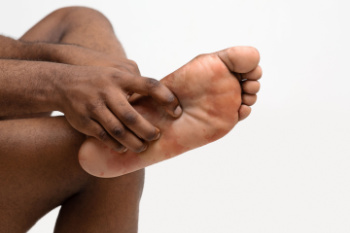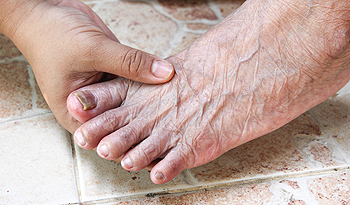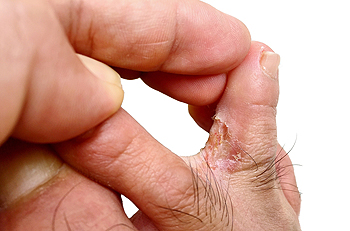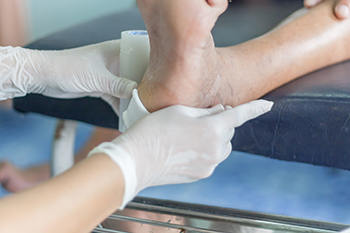Connect With Us
Blogs
Blog
Symptoms and Relief for Plantar Fasciitis

Plantar fasciitis is a condition that results in pain at the bottom of the foot, typically near the heel and arch. This pain often feels like a stabbing or bruising sensation, and may be most intense during the first steps in the morning. For some patients, the discomfort can also occur after standing for long periods of time, or when standing up after sitting for an extended time. Pain from plantar fasciitis may vary in intensity, with severe cases causing significant discomfort during daily activities. Risk factors include having flat feet, high arches, wearing unsupportive footwear, and standing for prolonged periods. Age, specific occupations, and certain pre-existing foot conditions can also contribute to the likelihood of developing plantar fasciitis. A podiatrist can assess your symptoms, identify the underlying causes, and provide effective treatment, such as custom orthotics or other methods to reduce stress on the plantar fascia and alleviate pain. If you have heel pain related to plantar fasciitis, it is suggested that you schedule an appointment with a podiatrist for an exam and treatment.
Plantar fasciitis can be very painful and inconvenient. If you are experiencing heel pain or symptoms of plantar fasciitis, contact Dr. Michael D. Garvin from Florida. Our doctor can provide the care you need to keep you pain-free and on your feet.
What Is Plantar Fasciitis?
Plantar fasciitis is the inflammation of the thick band of tissue that runs along the bottom of your foot, known as the plantar fascia, and causes mild to severe heel pain.
What Causes Plantar Fasciitis?
- Excessive running
- Non-supportive shoes
- Overpronation
- Repeated stretching and tearing of the plantar fascia
How Can It Be Treated?
- Conservative measures – anti-inflammatories, ice packs, stretching exercises, physical therapy, orthotic devices
- Shockwave therapy – sound waves are sent to the affected area to facilitate healing and are usually used for chronic cases of plantar fasciitis
- Surgery – usually only used as a last resort when all else fails. The plantar fascia can be surgically detached from the heel
While very treatable, plantar fasciitis is definitely not something that should be ignored. Especially in severe cases, speaking to your doctor right away is highly recommended to avoid complications and severe heel pain. Your podiatrist can work with you to provide the appropriate treatment options tailored to your condition.
If you have any questions please feel free to contact our offices located in Port St. Lucie, FL . We offer the newest diagnostic and treatment technologies for all your foot and ankle needs.
Causes and Diagnosis of Cuboid Syndrome

Cuboid syndrome occurs when the cuboid bone in the foot becomes partially dislocated or misaligned, leading to pain and discomfort. This bone is located on the outer side of the foot, and misalignment can result from repetitive stress, ankle sprains, or sudden twisting motions. Common symptoms include pain on the outside of the foot, difficulty walking, and a feeling of instability when standing. The pain may worsen with physical activity or pressure exerted on the foot. Diagnosing cuboid syndrome often involves a physical examination by a podiatrist, who may manipulate the foot to check for tenderness or abnormal movement of the cuboid bone. X-rays or other imaging tests may also be used to rule out other conditions and confirm the diagnosis. If you have pain on the outside of your foot, it is suggested that you consult a podiatrist who can determine the cause and provide treatment.
Cuboid syndrome, also known as cuboid subluxation, occurs when the joints and ligaments near the cuboid bone in the foot become torn. If you have cuboid syndrome, consult with Dr. Michael D. Garvin from Florida. Our doctor will assess your condition and provide you with quality foot and ankle treatment.
Cuboid syndrome is a common cause of lateral foot pain, which is pain on the outside of the foot. The condition may happen suddenly due to an ankle sprain, or it may develop slowly overtime from repetitive tension through the bone and surrounding structures.
Causes
The most common causes of cuboid syndrome include:
- Injury – The most common cause of this ailment is an ankle sprain.
- Repetitive Strain – Tension placed through the peroneus longus muscle from repetitive activities such as jumping and running may cause excessive traction on the bone causing it to sublux.
- Altered Foot Biomechanics – Most people suffering from cuboid subluxation have flat feet.
Symptoms
A common symptom of cuboid syndrome is pain along the outside of the foot which can be felt in the ankle and toes. This pain may create walking difficulties and may cause those with the condition to walk with a limp.
Diagnosis
Diagnosis of cuboid syndrome is often difficult, and it is often misdiagnosed. X-rays, MRIs and CT scans often fail to properly show the cuboid subluxation. Although there isn’t a specific test used to diagnose cuboid syndrome, your podiatrist will usually check if pain is felt while pressing firmly on the cuboid bone of your foot.
Treatment
Just as the range of causes varies widely, so do treatments. Some more common treatments are ice therapy, rest, exercise, taping, and orthotics.
If you have any questions, please feel free to contact our offices located in Port St. Lucie, FL . We offer the newest diagnostic and treatment technologies for all your foot care needs.
Why Your Feet Fight Back by Developing Corns

Corns are your feet’s defense mechanism against constant friction and pressure. These keratotic lesions form when the skin thickens to protect itself, often appearing on toes or pressure points where shoes rub the wrong way. What starts as a slight discomfort can turn into painful, hardened spots that make every step feel like walking on a pebble. Ignoring corns can lead to deeper, more painful layers of hardened skin, increasing the risk of infection, especially for those with diabetes or circulation issues. Mild treatments like pumice stones and moisturizing can help, but removing them yourself can do more harm than good. The real solution is addressing the root cause, which might be wearing ill-fitting shoes, toe deformities, or abnormal walking patterns. If corns keep coming back or become painful, it is suggested that you see a podiatrist for safe removal and long-term relief.
If you have any concerns regarding your feet and ankles, contact Dr. Michael D. Garvin of Florida. Our doctor will treat your foot and ankle needs.
Corns: What Are They? and How Do You Get Rid of Them?
Corns can be described as areas of the skin that have thickened to the point of becoming painful or irritating. They are often layers and layers of the skin that have become dry and rough, and are normally smaller than calluses.
Ways to Prevent Corns
There are many ways to get rid of painful corns such as wearing:
- Well-fitting socks
- Comfortable shoes that are not tight around your foot
- Shoes that offer support
Treating Corns
Treatment of corns involves removing the dead skin that has built up in the specific area of the foot. Consult with Our doctor to determine the best treatment option for your case of corns.
If you have any questions please feel free to contact our offices located in Port St. Lucie, FL . We offer the newest diagnostic and treatment technologies for all your foot and ankle needs.
Treatment and Prevention of Athlete’s Foot

Athlete's foot, or tinea pedis, is a fungal infection that commonly affects the skin on your feet, often starting with a red, itchy, and scaly rash between the toes. This condition thrives in warm, damp environments, making places like gym locker rooms, swimming pools, and public showers prime spots for picking it up. The fungus flourishes when it comes into contact with the skin in moist conditions, such as sweaty feet trapped in damp socks or shoes. Symptoms can range from mild itching and burning to peeling skin, and in severe cases, blisters or painful ulcers. For mild cases, antifungal creams, powders, or sprays can provide relief. However, the best defense is keeping your feet clean and dry, changing socks regularly and choosing breathable footwear can make a big difference. To prevent athlete's foot, always wear shower sandals in public areas, dry your feet thoroughly after washing, and avoid sharing towels or shoes. If symptoms persist or worsen, it is suggested that you make an appointment with a podiatrist for expert treatment.
Athlete’s Foot
Athlete’s foot is often an uncomfortable condition to experience. Thankfully, podiatrists specialize in treating athlete’s foot and offer the best treatment options. If you have any questions about athlete’s foot, consult with Dr. Michael D. Garvin from Florida. Our doctor will assess your condition and provide you with quality treatment.
What Is Athlete’s Foot?
Tinea pedis, more commonly known as athlete’s foot, is a non-serious and common fungal infection of the foot. Athlete’s foot is contagious and can be contracted by touching someone who has it or infected surfaces. The most common places contaminated by it are public showers, locker rooms, and swimming pools. Once contracted, it grows on feet that are left inside moist, dark, and warm shoes and socks.
Prevention
The most effective ways to prevent athlete’s foot include:
- Thoroughly washing and drying feet
- Avoid going barefoot in locker rooms and public showers
- Using shower shoes in public showers
- Wearing socks that allow the feet to breathe
- Changing socks and shoes frequently if you sweat a lot
Symptoms
Athlete’s foot initially occurs as a rash between the toes. However, if left undiagnosed, it can spread to the sides and bottom of the feet, toenails, and if touched by hand, the hands themselves. Symptoms include:
- Redness
- Burning
- Itching
- Scaly and peeling skin
Diagnosis and Treatment
Diagnosis is quick and easy. Skin samples will be taken and either viewed under a microscope or sent to a lab for testing. Sometimes, a podiatrist can diagnose it based on simply looking at it. Once confirmed, treatment options include oral and topical antifungal medications.
If you have any questions, please feel free to contact our offices located in Port St. Lucie, FL . We offer the newest diagnostic and treatment technologies for all your foot care needs.
Understanding What Hammertoe Is

Hammertoe is a deformity that affects the toes, causing them to bend downward at the middle joint, resembling a hammer. It typically occurs in the second, third, or fourth toes and can be caused by a variety of factors. One of the primary causes is wearing tight or ill-fitting shoes that force the toes into unnatural positions. Other contributing factors include muscle imbalances, injury, and certain medical conditions like arthritis. There are two main types of hammertoe, flexible and rigid. In flexible hammertoe, the toe can still be moved, whereas in rigid hammertoe, the joint becomes fixed in a bent position. The symptoms of hammertoe include pain or discomfort when wearing shoes, visible bending of the toe, calluses or corns on the top of the toe, and difficulty walking. If you have developed a hammertoe, it is suggested that you consult a podiatrist who can offer effective relief options, helping you to manage this condition.
Hammertoes can be a painful condition to live with. For more information, contact Dr. Michael D. Garvin of Florida. Our doctor will answer any of your foot- and ankle-related questions.
Hammertoe
Hammertoe is a foot deformity that occurs due to an imbalance in the muscles, tendons, or ligaments that normally hold the toe straight. It can be caused by the type of shoes you wear, your foot structure, trauma, and certain disease processes.
Symptoms
- Painful and/or difficult toe movement
- Swelling
- Joint stiffness
- Calluses/Corns
- Physical deformity
Risk Factors
- Age – The risk of hammertoe increases with age
- Sex – Women are more likely to have hammertoe compared to men
- Toe Length – You are more likely to develop hammertoe if your second toe is longer than your big toe
- Certain Diseases – Arthritis and diabetes may make you more likely to develop hammertoe
Treatment
If you have hammertoe, you should change into a more comfortable shoe that provides enough room for your toes. Exercises such as picking up marbles may strengthen and stretch your toe muscles. Nevertheless, it is important to seek assistance from a podiatrist in order to determine the severity of your hammertoe and see which treatment option will work best for you.
If you have any questions, please feel free to contact our offices located in Port St. Lucie, FL . We offer the newest diagnostic and treatment technologies for all your foot care needs.
Who Is Susceptible to Toenail Fungus?

Toenail fungus, or onychomycosis, is a common infection where fungi infiltrate the nail bed, leading to discoloration, thickening, and brittleness. Visually, affected nails may appear yellow, brown, or white, and can become distorted or crumbly. This condition arises when fungi enter through cracks in the nail or surrounding skin, thriving in warm, moist environments. Risk factors include advanced age, diabetes, poor circulation, and a history of athlete's foot. Treatment options encompass oral antifungal medications, topical treatments, and in some cases, surgical removal of the affected nail. Early intervention is critical to prevent the infection from spreading or causing further complications. If you suspect you have toenail fungus, it is suggested that you consult a podiatrist for an accurate diagnosis and personalized treatment plan.
For more information about treatment, contact Dr. Michael D. Garvin of Florida. Our doctor can provide the care you need to keep you pain-free and on your feet.
Toenail Fungus Treatment
Toenail fungus is a condition that affects many people and can be especially hard to get rid of. Fortunately, there are several methods to go about treating and avoiding it.
Antifungals & Deterrence
Oral antifungal medicine has been shown to be effective in many cases. It is important to consult with a podiatrist to determine the proper regiment for you, or potentially explore other options.
Applying foot powder on the feet and shoes helps keep the feet free of moisture and sweat.
Sandals or open toed shoes – Wearing these will allow air movement and help keep feet dry. They also expose your feet to light, which fungus cannot tolerate. Socks with moisture wicking material also help as well.
If you have any questions please feel free to contact our offices located in Port St. Lucie, FL . We offer the newest diagnostic tools and technology to treat your foot and ankle needs.
Problems Caused by Wearing Tight Shoes

Wearing shoes that are too tight can lead to various foot problems that affect the feet, toes, and ankles. Tight shoes create excessive pressure and friction, which may result in painful corns and calluses. These thickened areas of skin develop as a protective response to repeated irritation, often on the tops, sides, or bottoms of the feet. Ingrown toenails occur when tight footwear forces the nail into the surrounding tissue, leading to pain, swelling, and possible infection. Bunions, which are enlargements of the joint at the base of the big toe, can also develop or worsen due to wearing tight shoes. This condition often causes the big toe to press against adjacent toes, resulting in discomfort and inflammation. Additionally, tight shoes can lead to hammer toes, a deformity that causes toes to bend at the middle joint, making it challenging to wear shoes comfortably. A podiatrist can assess your foot issues and provide personalized treatment to relieve pain and prevent further complications. If you have foot pain that may be caused by wearing ill-fitting shoes, it is suggested that you schedule an appointment with a podiatrist for an exam and treatment.
Finding a properly-fitting shoe is important in reducing injuries and preventing foot problems. For more information about treatment, contact Dr. Michael D. Garvin from Florida. Our doctor will treat your foot and ankle needs.
Proper Shoe Fitting
A common concern when it comes to foot health, having properly fitted shoes can help prevent injuries to the foot. Out feet affect our posture and gait, which in turn affects the biomechanics and overall bodily structure. With 33 joints, 26 bones, and over 100 ligaments, the potential for serious injury is much greater than one realizes. Although the feet cease growth in adulthood, they still change shape as they mature. Here are some factors to consider when it comes to investing in proper fitting shoes:
- Be sure the shoes fit correctly right away
- Ensure the ball of your foot fits comfortably in the widest portion of the shoes
- Even though they may look fashionable, improper fitting shoes can either create adverse conditions or exacerbate existing ones you may already have
- Walk along a carpeted surface to ensure the shoes comfortably fit during normal activity
Keeping in mind how shoes fit the biomechanics of your body, properly-fitting shoes are vitally important. Fortunately, it is not difficult to acquire footwear that fits correctly. Be sure to wear shoes that support the overall structure of your body. Do your feet a favor and invest in several pairs of well-fitted shoes today.
If you have any questions please feel free to contact our offices located in Port St. Lucie, FL . We offer the newest diagnostic and treatment technologies for all your foot and ankle needs.
Improving Balance in Older Adults

Balance and mobility in older adults are strongly influenced by foot and ankle health. Key factors include ankle flexibility, the ability to sense touch on the soles, and the strength of toe muscles used to push down. These aspects are critical for steady movement and overall functional ability. When these characteristics decline, it can lead to impaired balance and increase the risk of falls. Strengthening exercises for the feet stretches to improve ankle flexibility, and strategies to enhance sensation in the soles, like using textured insoles, can help improve stability and movement. Such interventions not only boost confidence in mobility but also lower the chance of injury from falls. If you are a senior and balance issues or foot discomfort arise, it is suggested that you consult a podiatrist for a proper diagnosis and treatment.
If you need your feet checked, contact Dr. Michael D. Garvin of Florida. Our doctor will attend to all of your foot and ankle needs and provide you with quality treatment.
Geriatrics and Podiatry
When people age, some common issues that may occur are bone density loss, dry skin, poor circulation, and rough brittle nails. These issues may also affect your foot health if the necessary steps are not taken to alleviate the problems.
It is important to take care of your feet because feet that are injured or diseased can affect your overall health. Having painful feet hinders your ability to do daily activities or may decrease your willingness to do the things that you need to do.
Visiting Your Geriatrician
As we age, health problems become more likely, so it is essential to visit your doctor for check-ups to ensure that you are doing the best you can to take care of your health. It is recommended to check your feet frequently for any possible cuts, bruises, swelling, corns or any other irregularities.
Taking Care of Elderly Feet
Cracked or dry feet can be treated by applying moisturizer often. It is also important not to wear old socks because the older the sock is, the higher the possibility there will be that there is bacteria there. Wear fresh socks and make sure they fit properly.
Proper foot health means that you can have a more active lifestyle and you will not be bogged down by pain. Foot health also leads to good circulation, which is paramount for overall health.
If you have any questions, please feel free to contact our offices located in Port St. Lucie, FL . We offer the newest diagnostic tools and technology to treat your foot and ankle needs.
Painful Flat Feet

Flat feet, sometimes called fallen arches, occur when the arches of the feet collapse, causing the entire sole to touch the ground. This condition can lead to pain in the midfoot, especially after standing or walking for long periods. Other symptoms include swelling, foot fatigue, and even pain in the lower legs, knees, or lower back, as flat feet can affect your posture and gait. A variety of factors, including genetics, injury, obesity, or conditions like arthritis can cause flat feet. Over time, the lack of proper arch support can lead to increased strain on the muscles and joints in the feet. Treatment options for flat feet often include custom orthotics, which provide better arch support, stretches, strengthening exercises, and proper footwear. In some cases, surgical intervention may be necessary. A podiatrist can evaluate your condition and recommend the best treatment plan. If you are experiencing foot pain, it is suggested that you make an appointment with a podiatrist.
Flatfoot is a condition many people suffer from. If you have flat feet, contact Dr. Michael D. Garvin from Florida. Our doctor will treat your foot and ankle needs.
What Are Flat Feet?
Flatfoot is a condition in which the arch of the foot is depressed and the sole of the foot is almost completely in contact with the ground. About 20-30% of the population generally has flat feet because their arches never formed during growth.
Conditions & Problems:
Having flat feet makes it difficult to run or walk because of the stress placed on the ankles.
Alignment – The general alignment of your legs can be disrupted, because the ankles move inward which can cause major discomfort.
Knees – If you have complications with your knees, flat feet can be a contributor to arthritis in that area.
Symptoms
- Pain around the heel or arch area
- Trouble standing on the tip toe
- Swelling around the inside of the ankle
- Flat look to one or both feet
- Having your shoes feel uneven when worn
Treatment
If you are experiencing pain and stress on the foot you may weaken the posterior tibial tendon, which runs around the inside of the ankle.
If you have any questions please feel free to contact our offices located in Port St. Lucie, FL . We offer the newest diagnostic and treatment technologies for all your foot and ankle needs.
More...
What Causes Athlete’s Foot?

Athlete's foot is a fungal infection that affects the skin on the feet, causing itching, redness, peeling, and sometimes blisters. The fungus thrives in warm, moist environments, such as sweaty shoes or public areas like locker rooms and swimming pools. Athlete’s foot is extremely contagious, spreading through direct contact or by sharing contaminated items, like towels or footwear. This condition is caused by a group of fungi called dermatophytes, which invade the skin and cause irritation. While athlete's foot may be treated with mild antifungal creams or powders, severe or persistent cases may require stronger medications and professional care. If left untreated, athlete's foot can spread to other areas of the body, including the toenails or groin, and may cause complications like bacterial infections. A podiatrist can ensure proper treatment by providing targeted care and recommending preventive measures to avoid reinfection. If you are struggling with athlete's foot, it is suggested that you schedule an appointment with a podiatrist.
Athlete’s foot is an inconvenient condition that can be easily reduced with the proper treatment. If you have any concerns about your feet and ankles, contact Dr. Michael D. Garvin from Florida. Our doctor will treat your foot and ankle needs.
Athlete’s Foot: The Sole Story
Athlete's foot, also known as tinea pedis, can be an extremely contagious foot infection. It is commonly contracted in public changing areas and bathrooms, dormitory style living quarters, around locker rooms and public swimming pools, or anywhere your feet often come into contact with other people.
Solutions to Combat Athlete’s Foot
- Hydrate your feet by using lotion
- Exfoliate
- Buff off nails
- Use of anti-fungal products
- Examine your feet and visit your doctor if any suspicious blisters or cuts develop
Athlete’s foot can cause many irritating symptoms such as dry and flaking skin, itching, and redness. Some more severe symptoms can include bleeding and cracked skin, intense itching and burning, and even pain when walking. In the worst cases, Athlete’s foot can cause blistering as well. Speak to your podiatrist for a better understanding of the different causes of Athlete’s foot, as well as help in determining which treatment options are best for you.
If you have any questions please feel free to contact our offices located in Port St. Lucie, FL . We offer the newest diagnostic and treatment technologies for all your foot and ankle needs.
How to Properly Care for a Cut on the Foot

Caring for a cut on the foot is important to prevent infection and promote healing. First, clean the wound gently with mild soap and water to remove any dirt or debris. Apply a clean, sterile bandage to cover the cut and protect it from further injury or bacteria. It is essential to keep the area clean and dry to avoid complications. If the cut is deep or does not stop bleeding after applying pressure, seek attention from a podiatrist promptly. Mild antibiotic ointment can be applied to prevent infection, but be sure to change the bandage daily and monitor for signs of infection such as redness, swelling, or pus. Resting the foot and avoiding putting too much pressure on the wound can also aid in the healing process. If you have a cut on the foot or any type of foot wound, it is strongly suggested that you visit a podiatrist who can effectively treat foot wounds.
Wound care is an important part in dealing with diabetes. If you have diabetes and a foot wound or would like more information about wound care for diabetics, consult with Dr. Michael D. Garvin from Florida. Our doctor will assess your condition and provide you with quality foot and ankle treatment.
What Is Wound Care?
Wound care is the practice of taking proper care of a wound. This can range from the smallest to the largest of wounds. While everyone can benefit from proper wound care, it is much more important for diabetics. Diabetics often suffer from poor blood circulation which causes wounds to heal much slower than they would in a non-diabetic.
What Is the Importance of Wound Care?
While it may not seem apparent with small ulcers on the foot, for diabetics, any size ulcer can become infected. Diabetics often also suffer from neuropathy, or nerve loss. This means they might not even feel when they have an ulcer on their foot. If the wound becomes severely infected, amputation may be necessary. Therefore, it is of the upmost importance to properly care for any and all foot wounds.
How to Care for Wounds
The best way to care for foot wounds is to prevent them. For diabetics, this means daily inspections of the feet for any signs of abnormalities or ulcers. It is also recommended to see a podiatrist several times a year for a foot inspection. If you do have an ulcer, run the wound under water to clear dirt from the wound; then apply antibiotic ointment to the wound and cover with a bandage. Bandages should be changed daily and keeping pressure off the wound is smart. It is advised to see a podiatrist, who can keep an eye on it.
If you have any questions, please feel free to contact our offices located in Port St. Lucie, FL . We offer the newest diagnostic and treatment technologies for all your foot care needs.
Foot Problems From Working on Your Feet

Spending hours on your feet at work can lead to pain and problems in the feet, toes, and ankles. Common conditions like plantar fasciitis and bunions can develop or worsen due to prolonged standing, often linked to wearing poorly fitting shoes that lack adequate support. Wearing shoes with proper arch support and a slight heel elevation, ideally between one quarter to two inches, can help reduce foot strain. Ensuring shoes fit correctly, with adequate space for toes and a secure heel, prevents issues like blisters and circulatory problems. Stretching exercises, such as calf raises and wall stretches, can improve blood flow, ease muscle tension, and reduce discomfort after long shifts. A podiatrist can assist with diagnosing the source of foot pain and may recommend exercises, custom orthotics, or other ways to alleviate discomfort and prevent complications. This foot doctor can also provide suggestions on selecting footwear that best supports your specific needs. If you often experience foot pain after working on your feet, it is suggested that you schedule an appointment with a podiatrist for an exam and treatment.
While working on the feet, it is important to take the proper care of them. For more information about working on your feet, contact Dr. Michael D. Garvin from Florida. Our doctor will treat your foot and ankle needs.
Working on Your Feet
Standing on your feet for long periods of time can cause stress and pain in your feet. Your whole body may experience change in terms of posture, back pain, bunions, callouses and or plantar warts. There are ways to avoid these conditions with proper foot care, smart choices and correct posture.
Positive Changes
Negative heeled shoe – Choosing this shoe type places the heel slightly lower than the ball of the foot. These are great for overall foot health. Find shoes that fit you correctly.
Go barefoot – Our feet were not designed to be enclosed for all hours of the day. Try to periodically expose your feet to air.
Eliminate Pain
Foot Exercises – Performing simple exercises, incorporating yoga and doing stretches are beneficial. This will allow increased blood flow to the area and muscles of the foot.
Achilles tendon – Stretching the foot out flat on the floor will relax the calf muscles and tendon. These exercises can be performed almost anywhere. Make sure you add these exercises to your daily regimen.
With a little bit of this information and knowing more about foot health, you will notice changes. Foot stretches and proper footwear will help with pain and prevent further issues.
If you have any questions please feel free to contact our offices located in Port St. Lucie, FL . We offer the newest diagnostic and treatment technologies for all your foot and ankle needs.


